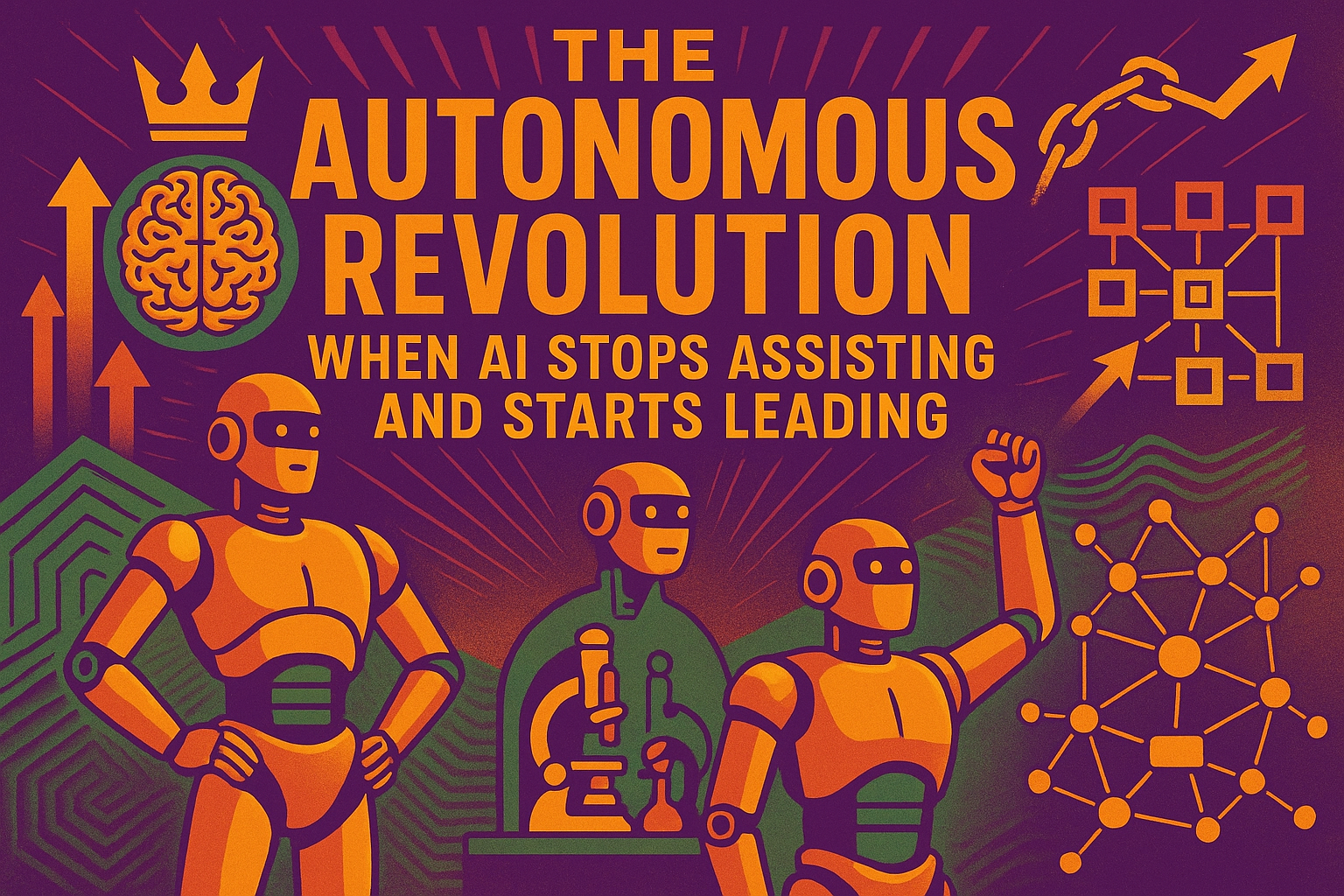← Back to Articles

Three recent announcements redefined AI capabilities: Stanford's virtual scientists conducting independent research, Allen Institute's robots thinking in 3D space, and Microsoft integrating human-level intelligence across enterprise workflows. This convergence signals the transition from AI assistance to AI leadership.
Stanford's Virtual Lab represents the most significant breakthrough in autonomous AI research. Published in Nature, the system features an LLM principal investigator agent guiding specialist scientist agents through complete research cycles. The virtual lab designed new SARS-CoV-2 nanobodies in days, a process typically requiring months of human research. The system demonstrates emergent behaviors where agents collaborate, debate findings, and reach consensus without human intervention, operating at machine speed while delivering results that exceed human performance.
Allen Institute's MolmoAct launch introduced the first AI model capable of three-dimensional spatial reasoning for robotics. Unlike previous systems processing 2D information, MolmoAct enables robots to "think" in three dimensions, planning complex movements and understanding spatial relationships in real-time. The system processes visual input, constructs 3D mental models, and plans movement sequences accounting for spatial constraints and dynamic changes. Companies deploying MolmoAct-powered robots gain significant advantages in manufacturing, logistics, and service industries.
Microsoft's GPT-5 integration across consumer, developer, and enterprise platforms represents the largest deployment of human-level AI intelligence in history. Spanning Azure AI Foundry, Visual Studio Code, GitHub workflows, and Microsoft 365, the integration provides millions of users with advanced AI capabilities. Developers gain access to AI handling longer, more complex coding tasks while business users leverage human-level intelligence for analysis and strategic planning. The integration creates a unified AI ecosystem where intelligent agents collaborate across applications.
The timing creates unprecedented competitive pressure. Organizations planning gradual AI adoption now face competitors with autonomous research capabilities, 3D-thinking robots, and human-level intelligence integrated across operations. Market data supports this urgency: half of U.S. adults now use AI, indicating mainstream adoption has reached critical mass. The $3 billion AI facility announced in North Dakota demonstrates infrastructure investments required for autonomous AI systems.
TL;DR:
• Stanford's Virtual Lab enables AI systems to conduct independent scientific research autonomously
• Allen Institute's MolmoAct gives robots 3D spatial reasoning and autonomous movement planning
• Microsoft integrated GPT-5 across enterprise platforms, providing human-level AI at global scale
• Three breakthroughs signal transition from AI assistance to AI autonomy and leadership
• Half of U.S. adults now use AI, indicating mainstream adoption has reached critical mass
The Autonomous Revolution: When AI Stops Assisting and Starts Leading
agents.one • Aug 19, 2025

Stanford's Virtual Lab represents the most significant breakthrough in autonomous AI research. Published in Nature, the system features an LLM principal investigator agent guiding specialist scientist agents through complete research cycles. The virtual lab designed new SARS-CoV-2 nanobodies in days, a process typically requiring months of human research. The system demonstrates emergent behaviors where agents collaborate, debate findings, and reach consensus without human intervention, operating at machine speed while delivering results that exceed human performance.
Allen Institute's MolmoAct launch introduced the first AI model capable of three-dimensional spatial reasoning for robotics. Unlike previous systems processing 2D information, MolmoAct enables robots to "think" in three dimensions, planning complex movements and understanding spatial relationships in real-time. The system processes visual input, constructs 3D mental models, and plans movement sequences accounting for spatial constraints and dynamic changes. Companies deploying MolmoAct-powered robots gain significant advantages in manufacturing, logistics, and service industries.
Microsoft's GPT-5 integration across consumer, developer, and enterprise platforms represents the largest deployment of human-level AI intelligence in history. Spanning Azure AI Foundry, Visual Studio Code, GitHub workflows, and Microsoft 365, the integration provides millions of users with advanced AI capabilities. Developers gain access to AI handling longer, more complex coding tasks while business users leverage human-level intelligence for analysis and strategic planning. The integration creates a unified AI ecosystem where intelligent agents collaborate across applications.
The timing creates unprecedented competitive pressure. Organizations planning gradual AI adoption now face competitors with autonomous research capabilities, 3D-thinking robots, and human-level intelligence integrated across operations. Market data supports this urgency: half of U.S. adults now use AI, indicating mainstream adoption has reached critical mass. The $3 billion AI facility announced in North Dakota demonstrates infrastructure investments required for autonomous AI systems.
TL;DR:
• Stanford's Virtual Lab enables AI systems to conduct independent scientific research autonomously
• Allen Institute's MolmoAct gives robots 3D spatial reasoning and autonomous movement planning
• Microsoft integrated GPT-5 across enterprise platforms, providing human-level AI at global scale
• Three breakthroughs signal transition from AI assistance to AI autonomy and leadership
• Half of U.S. adults now use AI, indicating mainstream adoption has reached critical mass